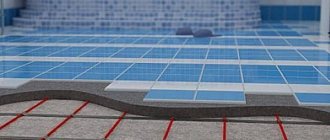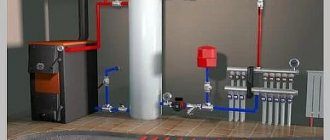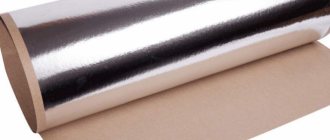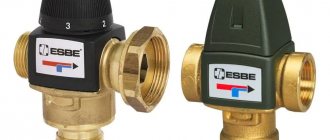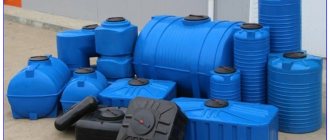The uninterrupted operation of any heating device depends on the correct selection of components, and water heated floors are no exception. In this design, an important point is given to maintaining the temperature level and intensity of coolant supply - this function is assigned to shut-off valves: a two-way or three-way valve.
In our article we will tell you what a three-way valve is, the principle of its operation, and what types there are. You will also learn which valve to choose for a heated floor, as well as how to install it yourself.
Application area
Underfloor heating systems are increasingly popular in residential buildings today, but without a control valve it is impossible to ensure proper heating. A three-way tap is an element designed to adjust the heating level in a water floor that is filled with screed.
The valve is installed both as a complete set with a mixing and distribution unit, and as an independent device. In small rooms (bathtub, toilet, kitchen), there is no point in installing a multifunctional collector - it is expensive and not justified.
A three-way thermomixing valve can control the temperature and regulate the volume of liquid for such rooms.
Main areas of use:
- In a radiator heating system.
- In the DHW system.
- In warm floors.
Battery connection methods
Batteries can be installed in a structure such as a single-pipe heating system for a two-story house (a photo of such equipment is clearly demonstrated on the page) using any of the currently available technologies. The connection diagram is:
- Lower. In this case, the “supply” and “return” pipes are connected to the battery from below.
- Diagonal. With this scheme, the pipes are connected to the radiator from above and below from opposite sides.
- Vertical. In this case, the main line is connected at the top and bottom on one side.
To ensure that the air in both the rooms farthest and those closest to the boiler is heated evenly, radiators are usually connected to the pipe bypass. This creates a simplified analogue of a two-pipe system. With a bypass, it is easy to regulate the volume of flow passing through the radiator.
Functions
Water heated floors have significant differences from standard radiator heating. The floor pipeline, which lies in a cement screed, requires water at a certain temperature level, much lower than that circulating in the radiators. Therefore, it is necessary to install a three-mix running unit, in which the coolant will be brought to the required degree.
Bringing the liquid to the required degree of heating that meets the standards for underfloor heating (which ranges from +35 to 55 degrees) is the main function of a three-way thermomixing valve.
Design and principle of operation
A mixing valve is a device for mixing and regulating water flows; it has three openings: two inlet and one outlet. In the space between the inlet holes there is a heat-sensitive damper; it is responsible for regulating the movement of liquid - cooled and heated. Modern devices are equipped with a thermal head or control valve.
The heating floor valve operates continuously. The step-by-step process is as follows:
- heated water is supplied to the first inlet - its temperature is determined in the valve;
- if the heating degree of the water exceeds that required for heated floors, then the supply of cooled liquid from the return line opens through the second hole;
- inside the valve, heated liquid is mixed with cooled liquid;
- after obtaining the desired temperature, the return flow is closed;
- The coolant is supplied through the outlet to the underfloor heating pipes.
For the thermal valve to work effectively, it is necessary to maintain constant pressure in the line.
When operating an automatic thermo-mixing tap equipped with a servo drive, heating is carried out in 3 minutes ; if there is a thermal head, the liquid is heated in 15 minutes .
Kinds
Esbe three-way for heated floors, why is it needed.
Three-way thermal valves come in separate and mixing types. For underfloor heating, mixing valves are used.
In addition, they have different implementation methods; they can be manual or automatic. They also differ in their design - the location of the holes (inlet and outlet).
Manual
The price of a manual device is not high, but it is rarely used because it is not convenient. Suitable only for small rooms - bath, kitchen. The temperature level and volume of supplied coolant are adjusted manually using a handle.
Automatic
Automatic valves have a thermal head or an electric drive, which can be controlled by a sensor.
Types of mixing units:
- Simple - if the temperature rises, the liquid expands, the damper opens, cold and hot water mix.
- Three-way valves with a thermal head with a remote thermostat for heated floors are more advanced models. They are widely used because they are accurate and do not require electricity to operate. Average price from 500 rubles to 2500 rubles.
- Three-way valves for heating with a thermostat - they regulate the flow of heated and cooled water, and also control the temperature with a built-in thermostat. The expansion and contraction of the holes occurs automatically, depending on the temperature of the liquid.
- With an electric drive (drive with a magnet or servo drive) - the damper in the valve is activated under the influence of an electric motor, it is controlled by a controller, and a signal is received from a temperature sensor. They are easy to connect, so they are widely used. But unreliability is their main drawback, since they depend on electricity. Their cost is higher than with a thermal head, approximately 4 - 5 thousand rubles.
- With pneumatic or hydraulic drive - used more often in production, for devices with high pressure. They have a high cost, but their service life is longer.
- Electronic - adjustment is carried out by a built-in electric motor or a control element with a thermometer.
Manufacturing materials
Three-way thermomixing valves are made from the following materials:
- Brass is a copper alloy with zinc additives. The product is not subject to corrosive destruction, it is strong and durable. Sometimes these thermomixers have a chrome or nickel coating, which protects against darkening. This option is most often used in residential areas.
- Bronze is a copper alloy with tin additives. It is rare, although the quality is no worse than brass.
- Stainless steel is an excellent metal for making control products. It is characterized by durability, strength, and corrosion resistance. But the cost of appliances made from it is high, so they are not suitable for a private home.
There are titanium and carbon steel regulators, but they are recommended for industrial use. Valves are produced from silumin (an alloy of aluminum and silicon), their disadvantage is low strength.
Pipe selection
For water heated floors, it is allowed to use materials that meet specific requirements. These include: durability, no welds. There are a number of standards regarding the outer diameter of the pipe and the permissible length:
- 16 mm – from 50 to 80 m;
- 20 mm – up to 100 m;
- 25 mm – up to 120 m.
The heated floor is configured to work with coolant at low temperatures. But the reserve must take into account unforeseen circumstances. Therefore, the characteristics should include temperatures up to 95 0C.
Stainless steel corrugation
These pipes can be spliced. The fittings that are used in this case are considered the most reliable among others. The material meets all requirements and is easily bent while maintaining position. The outside is covered with high-density polyethylene.
Copper
When metal oxidizes, it becomes covered with a layer of patina, so copper protects itself from corrosion. Thanks to this fact, pipes last from 50 to 200 years. Positive aspects are also high heat transfer and ductility with mechanical strength. For heated floors, products in a polymer shell are used.
Copper pipe for underfloor heating Source wieland-plumbing.com
Polypropylene
Such pipes are not used for water heated floors. The material is resistant to bending, so it is impossible to organize a step of 20 cm without soldering. And this is unacceptable. In addition, polypropylene has low heat transfer, which is not relevant for the operation of a low-temperature system.
Polyethylene
Such pipes are made of cross-linked polyethylene. The material has a classification, which is designated by letters from PEX-a to PEX-d. For water heated floors, only the first group is recommended for use. The second option shrinks over time, the third is cheaper, but inferior in quality characteristics. The latter product is being withdrawn from production, since production is accompanied by the participation of nitrogenous compounds.
An alternative material for making pipes is PE-RT. This polyethylene lasts for more than 50 years and can withstand several freezing cycles with water inside without loss of characteristics or shape. Connections can be made by fittings or welding.
Metal-plastic
Polyethylene pipes with aluminum reinforcement last no more than 30 years. The flexible material is sold in coils up to 50 m long. If you need more, you can place an order with the manufacturer and increase the size to 80 m. The best option would be material made from PEX-a, PEX-b or PE-RT.
Metal-plastic pipes for heated floors Source zkheizung.de
It is important to purchase quality materials. Different thermal expansion of polyethylene and metal leads to delamination. Thin layers of 0.8 mm and 0.2-0.4 mm, respectively, cannot always cope with interruptions without consequences. Therefore, before choosing, you need to require accompanying documentation: certificates of quality and compliance.
Advantages and disadvantages
Three-way thermostatic mixing valves are simple in design, yet reliable and durable. Their use allows for high-quality and precise control of the floor heating level.
Thermostatic valve for heated floors: types and their design, how to choose, installation diagrams and alternative connection methods
The devices are sealed and compact. Plus - they do not allow the pipes and screed to overheat, which extends the life of the system.
The benefits of control valves are irrefutable, but they have a number of disadvantages:
- They increase hydraulic resistance - this negatively affects the functioning of a unit that has more than one collector.
- There is a risk of a large volume of hot coolant entering the floor pipes. And this can lead to leakage and airing of the system. Such problems most often occur when the device is starting up.
How much does a finished unit cost?
Of course, you don’t have to worry about studying the operating diagrams of different types of connections, but buy an already assembled version of the system. You can find such options in construction stores, but their prices are high. But this will save you from errors during assembly and calculations, because you need to know well the purpose of each part.
Example of incorrect connection
For example, the most popular Italian mixing unit for heated floors, Valtec, with a pump in Russia, will cost you about 15 thousand rubles. An equally popular American mixing unit for heated floors, Watts Isotherm, also costs between 15-16 thousand. If you want to save money, you can assemble such a unit with your own hands from individual parts.
Manufacturers
Preference should be given to mixing valves from manufacturers that have proven themselves well in the market. Such companies include:
- Esbe (Sweden) - occupies a leading position in the quality of products of this type. The valves are reliable, with a warranty period of more than 5 years.
- Valtec is a Russian-Italian company; its mixing taps have good characteristics at an affordable price. Warranty - 7 years.
- Honeywell (America) - the priority of mixers from this company is considered to be convenient and uncomplicated installation. They are reliable, but expensive.
However, it should be remembered that even high-quality products if installed incorrectly will not ensure correct operation of the system.
Heating with liquefied gas
Propane-butane is a liquefied gas that is used to fill cars with a gas engine and the well-known “dacha” red gas cylinders. It provides the best combination of price and comfort after natural gas.
For autonomous heating of a private house with gas, it is necessary to install an underground gas tank on the site. One gas tank holds several thousand liters of liquefied gas. This volume is enough to heat the house for many months. When the gas tank is empty (this happens once or twice a year), it will be replenished by special refueling vehicles.
Low price. Propane-butane is one and a half to two times cheaper than electricity or diesel fuel: 2.57 rubles per kWh versus 4.01 rubles for electricity and 4.75 rubles for diesel fuel.
In practice, this means the difference between 49 thousand rubles - the cost of heating 100 square meters with liquefied gas for a year - and 90 thousand rubles - a much more significant amount that would have to be paid when using diesel fuel.
Convenience. Like natural gas or electricity, propane-butane is supplied to the heating system without human intervention. This is not firewood or coal that needs to be thrown in several times a day. Liquefied gas does not require regular loading and constant supervision. The gas holder needs to be refilled once or twice a year, and this is done by a professional, not the homeowner. In winter, snow may need to be cleared so that the gas station can access the site. This is the worst thing that can happen.
Doesn't take up space. The gas tank is located underground. You can walk on it, herbaceous plants and even bushes can grow over it. During operation, the gas heating system does not emit a noticeable odor. There is no comparison with firewood, coal, pellets or diesel fuel, the storage of which will have to waste space on the site or in the house.
Disadvantages of heating with liquefied gas
- Sometimes you have to clear snow for winter delivery.
How to choose?
It is recommended to select a three-way valve in specialized stores. When choosing a model, you need to take into account its characteristics. When purchasing a device you need:
- study all documentation - warranty, manufacturer’s certificate, installation and operating instructions;
- give preference to bronze or brass devices - they will not expand when heated;
- based on the valve capacity - this parameter must correspond to the boiler performance;
- select a valve with a cross-section that exactly matches the size of the floor pipes; if there is a mismatch, you will have to buy adapters.
An important point is that even the apparent coincidence of the diameters of the valve inlet and outlet does not indicate the throughput level. This is affected by the size of the internal cross-section of the holes. This parameter is specified in the accompanying documents.
You need to choose a device based on the size of the heated room - for large areas an automatic device is recommended; it is able to maintain heating at the proper level. For small rooms, a simple one with a thermal head will do the job, so there is no point in overpaying for a more complex model.
When purchasing, you must visually inspect the device for chips and cracks. If the device is brass, then the inside should be golden.
Purchasing automatic devices will facilitate the adjustment process. And the presence of software will allow you to adjust the temperature taking into account the time and day of the week.
Heating with coal or wood
Wood and coal share the same disadvantages. They require very frequent loading (so often that a large house may need a stoker), require regular ash cleaning, and their storage takes up a fair amount of space on the property. In addition, they also emit a strong odor.
Frequent downloads. Firewood needs to be loaded into the heating system three to four times a day. Over the course of a season, this will take at least 147 hours. More than three working weeks of continuous physical labor, worked from bell to bell. It is not surprising that many people prefer to find a stoker. However, this in turn affects the price. Taking into account the payment for the stoker, heating a house with an area of 100 square meters using firewood for a year will cost 97 thousand rubles. This is more than the same amount for diesel fuel (90 thousand rubles) or electricity (76 thousand rubles).
Coal is not particularly better in this regard. It must be loaded into the heating system two to three times a day, that is, a little less often than firewood. As a result, the cost of time (and, accordingly, money if you have to pay a stoker) turns out to be slightly less than when using firewood, but the difference is insignificant: 101 thousand rubles for heating a house with an area of 100 square meters, taking into account the payment of the stoker.
In fairness, it should be noted that this problem has a partial solution. There are special boilers with a bunker into which coal is filled not several times a day, but only once every three to four days. This is a significant improvement over refueling every few hours, but compared to propane-butane or even diesel fuel it looks rather pale.
Warehouse space. The peculiarity of firewood is the need for a large room for storage and drying. To avoid wasting up to 40% of energy on moisture evaporation, they must be dried for three years. A large room will take up part of the site that could otherwise be put to more useful use. Coal storage also requires a significant area.
Danger of poisoning. An unpleasant odor is a constant companion of any type of solid fuel, but in this case we can talk about a threat not only to smell, but also to life. If the boiler room is located directly in the house, when using solid fuels, the danger of carbon monoxide poisoning cannot be completely eliminated.
Disadvantages of heating with wood or coal
- Very frequent downloads.
- The need to clean up the ash and pay for the stoker.
- Smell in the house and area.
- Part of the site is occupied by a warehouse.
Heated floor diagram with a three-way valve
A three-way valve can be installed together with a mixing and distribution unit, or as a separate device.
Three-way valve. We install it correctly.
Scheme with separately installed valve
If the valve is mounted separately, it takes over all the functions of the manifold. This scheme is intended for small rooms, no more than 25 m2. The temperature level is adjusted using a special device and a thermostat, they are located in the valve.
The disadvantage of using a valve according to this scheme is that there is no way to dose the flows.
The system looks like this:
- a three-way valve is installed on the hot coolant supply pipe;
- a temperature sensor is attached behind it;
- Next, a circulation pump is installed; it will deliver water with the required heating degree to the sex pipeline.
Scheme without mixing unit
Valve with mixing unit
If the area is large, then it is necessary to use a scheme where the valve is part of the distribution unit.
It will ensure uninterrupted operation of the floor heating device, and the water entering the floor line will be at the required temperature and volume.
The connection diagram is as follows:
- a pump is installed on the supply pipe; it will pump the heated coolant from the source;
- then a temperature sensor is installed, it will control the degree of heating;
- at the next stage, a three-way valve is attached - it mixes the coolant to a given degree;
- a tap is placed on the return circuit through which cooled water will flow into the three-way device.
Scheme with a mixing unit
That is, coolant heated to the required temperature will be supplied to the underfloor heating pipes.
Connection diagrams depending on design
In addition, the connection diagrams differ in the design and direction of the coolant in the device, there are:
- L-shaped - the product is equipped with two holes on the side and one round hole on the bottom of the body. The heated liquid is supplied to the side inlet, and the cooled liquid is supplied to the bottom. After mixing, the water moves into the floor branches through another side hole.
- T-shaped - both flows, cold and hot, enter the mixer through the side inlets. The mixed coolant is sent to the floor through the central lower outlet.
When deciding on a diagram for installing a three-position valve, you should consider how it will fit into the pipeline piping.
Installation and connection of a three-way valve to a warm floor
Connecting a three-way valve to a warm floor is not difficult; you can do it yourself. The main thing is to follow the steps according to the attached instructions.
All inputs and outputs are indicated by letters:
- A - input for heated coolant;
- C - inlet for chilled water;
- AB is the outlet.
Before connecting the device, it should be taken into account that it may need to be dismantled, so it is necessary to have an unobstructed approach to the unit.
Materials and tools
Before installing the valve, you need to stock up on the necessary tools. You will need wrenches (2 pcs), pliers, American nuts with union-type gaskets, FUM tape.
Work progress
Connecting a heated floor to the heating system. Three-way mixing valve.
First of all, the three-way valve must be checked for functionality.
To do this, the minimum value is set on the regulator, then hot water is released through the valve. If the device is functioning correctly, the damper should close immediately.
Installation of the tap must be done together with the installation of the manifold group and before pouring the screed.
When using any scheme, the valve is installed using American union nuts.
The work looks like this:
- The fittings located at the ends of the pipes are cleaned of dirt and burrs.
- The same procedure is done with the valve pipes.
- The nut is checked for gaskets.
- Then screw the nuts onto the pipes and tighten them - but not too much. This procedure involves two wrenches - one for tightening the nut, the second for holding the valve.
- A mechanical filter is installed in front of the valve.
It is necessary to monitor the correct connection of the valve outputs: to A - hot water, to B the bypass coming from the return line, to AB the manifold with floor outlets.
To ensure the tightness of the joints, it is recommended to screw plumber's tape or FUM tape.
System check
In addition to the correct installation of the mixing tap, its operation must be checked. System testing is carried out with the coolant heated to 25 degrees. The time for crimping is 24 hours.
After checking, you can proceed to pouring the screed.
Common installation mistakes
The most common mistake when installing a three-way valve is that the supply and return floor circuits are incorrectly connected. For example, when floor contour pipes are connected to the inlet.
Therefore, care is required; for this, there are letter designations at the mixer outputs. If you mix up the holes, the device will not function.
In addition, it is necessary to strictly follow the manufacturer's instructions regarding the distance between straight sections before and after the screw. If this rule is violated, the functioning of the regulator will be disrupted.
Rules for installing fittings
Typically, the manufacturer indicates the movement of water flow with arrows on the body of a three-way valve. Using these guidelines, you can determine the type of valve. Connection to the system occurs as indicated by the arrows. The installation location should be convenient for subsequent adjustments or replacement in case of malfunction. Both return and supply are suitable for this. But read the instructions carefully, since not all valves can be installed for supply.
Since most of the valves inside are made of ceramic, they do not handle dirty water well. Therefore, it is better to install a filter in front of the valve. If this is not done, the device may become clogged. In some cases, it is enough to clean it, but sometimes even this does not save. Therefore, you should not skimp on filters.
The electric drive should not be located at the bottom, and mechanical thermostatic mixers are also not recommended to be installed this way, only vertically. But I can say from my own experience that in some cases this is possible. And reviews from some owners confirm this.
Features of operation
When operating a heated floor mixing valve, there are special points. The main one is the mandatory installation of a filter. In addition, it is not recommended to place a mixer with a thermal head in a manifold group that serves more than one room or is located in an adjacent room. A device with a remote temperature sensor placed in a heated room is suitable.
The mixing valve is the main element in the water heated floor system. The quality of room heating depends on how correctly it works. Therefore, its selection and installation must be approached responsibly. If you are not confident in your abilities, then it is better to invite a professional.
Conclusion
The installation scheme for a heated floor is selected based on the area of a specific room, based on the heating option. Laying pipes with a snail is a universal and economical way to heat a room in any weather conditions.
The longer the plastic pipes are, the more powerful the pump should be. After all, you will need good pressure and the need to overcome large hydraulic resistance.
It is better to purchase and install adjustable pumps that have three speeds.


